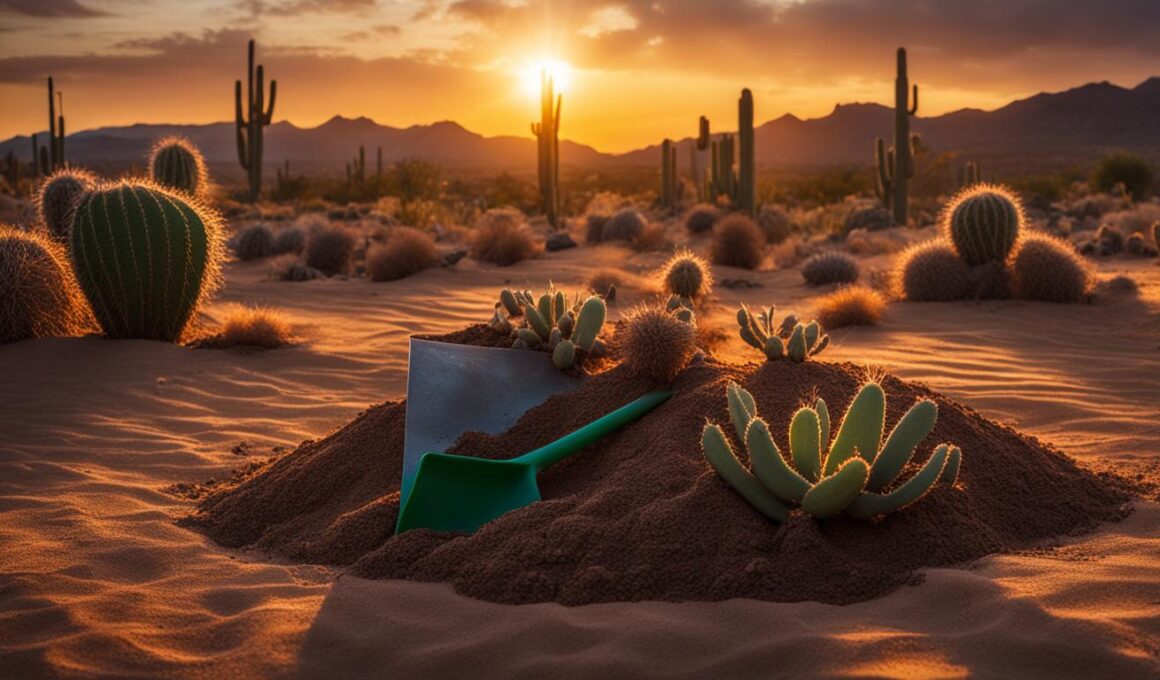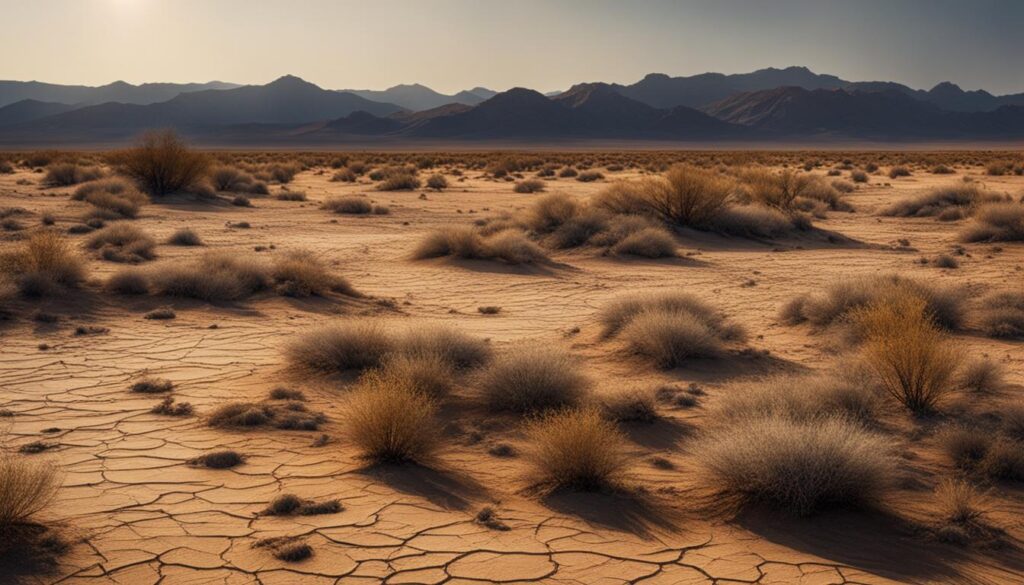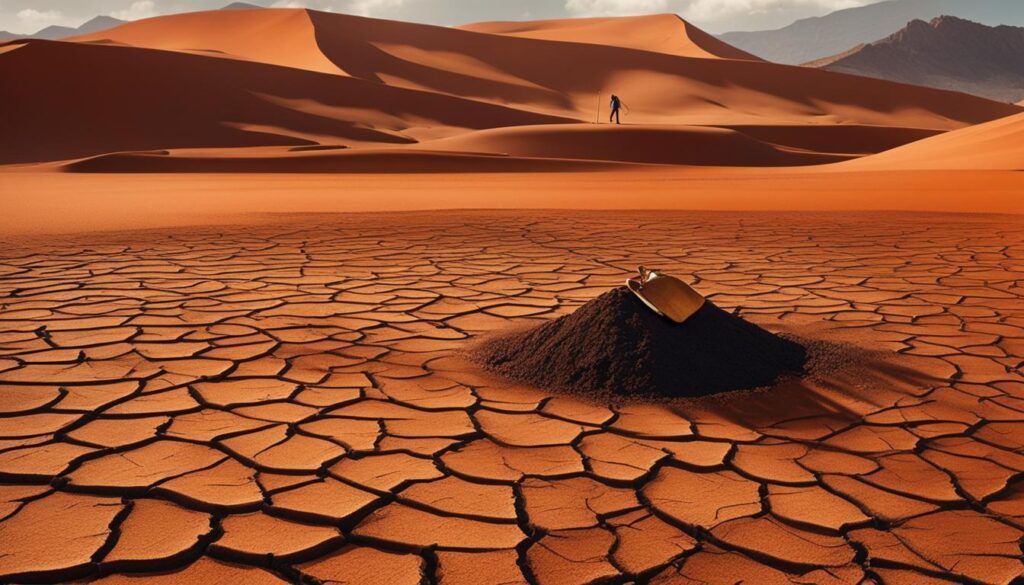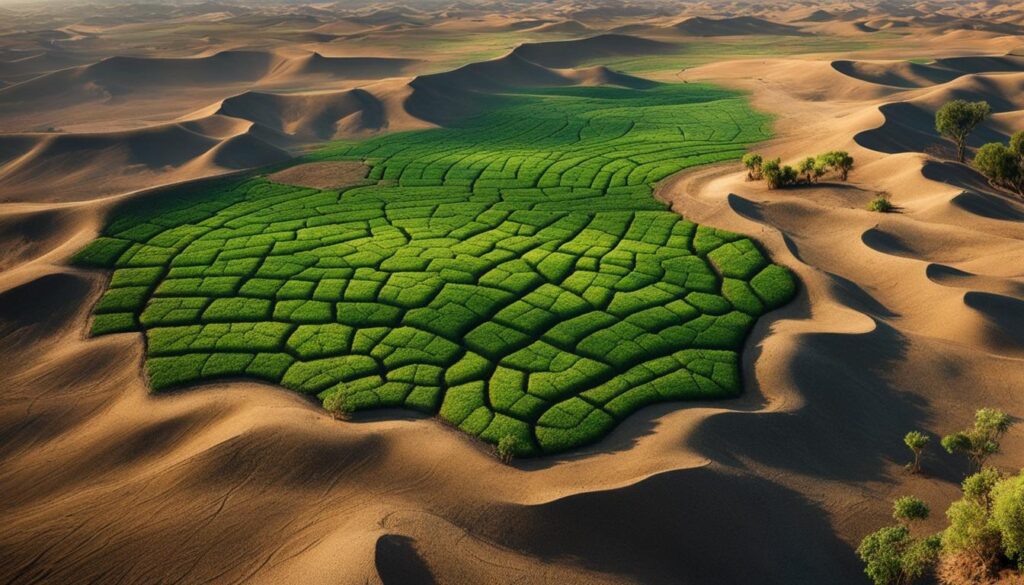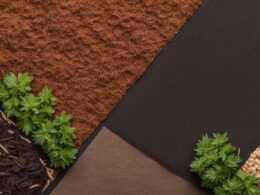When it comes to creating a thriving landscape in the desert, one of the biggest challenges is the condition of the soil. Desert soils are notoriously hard and compact, with high pH levels that can prevent plant growth. However, with the right soil conditioners, you can transform your desert landscape into a lush oasis. In this article, we will explore the best soil conditioners for desert landscaping and how they can improve the health and fertility of your soil.
Key Takeaways:
- Desert soils are hard, compact, and have high pH levels.
- Moon Valley Landscape Soil Conditioner is recommended for desert landscapes.
- The conditioner contains sulfur and gypsum to counteract salt buildup and loosen tough soil.
- Regular applications of the conditioner will lead to better drainage and healthier soils.
- Optimizing soil conditions is crucial for successful desert landscaping.
Understanding the Challenges of Desert Soils
Desert soils pose unique challenges for gardeners due to their high pH levels and compact nature. These characteristics make it difficult for plants to thrive in arid environments. Understanding these challenges is crucial to effectively address them and create a successful desert landscape.
One of the main challenges of desert soils is their high pH level. With pH levels above 8.0, the soil becomes alkaline and hinders the absorption of essential nutrients by plants. This can lead to nutrient deficiencies and stunted growth. Adjusting the pH level of the soil is necessary to create a favorable environment for plants to thrive.
Another challenge of desert soils is their compact nature. The soil particles are tightly packed together, reducing water infiltration and drainage. This can result in waterlogged soil and root rot. Improving the soil structure by loosening the compacted soil is crucial to promote healthy root growth and enhance water drainage.
To overcome these challenges, it is important to incorporate the right soil amendments. These amendments can help lower the pH level, break up compacted soil, and improve overall soil health. By addressing these challenges, gardeners can create an environment that supports plant growth and ensures the success of their desert landscape.
Table: Challenges of Desert Soils
| Challenges | Description |
|---|---|
| High pH levels | Alkaline soil hinders nutrient absorption by plants. |
| Compact soil | Tightly packed soil reduces water infiltration and drainage. |
Optimizing Soil pH with Elemental Sulfur
One of the main challenges of desert gardening is the high pH levels of the soil, which can inhibit nutrient absorption by plants. To address this issue, elemental sulfur can be used to lower the pH level and create a more favorable environment for plant growth. Elemental sulfur undergoes oxidation in the soil, converting to sulfuric acid. This acid breaks down caliche, a hard layer of calcium carbonate found in many desert soils, and helps to make the soil more acidic.
To effectively lower the pH level of desert soil, it is recommended to apply 15-20 pounds of Dr. Q’s Soil Sulfur per 1,000 square feet of land. The sulfur should be tilled into the soil at a depth of 6-8 inches. It is important to note that sulfur application should be avoided during the hot summer months, as high temperatures can negate the desired chemical reaction. Additionally, it is crucial to use elemental sulfur instead of ammonium sulfate, as the latter will not produce the same pH-lowering effect.
Benefits of Using Elemental Sulfur:
- Reduces soil pH and counteracts alkaline conditions
- Breaks down caliche, improving soil structure and drainage
- Enhances nutrient availability to plants
“Improving soil pH through the use of elemental sulfur is a key strategy for successful desert gardening. By creating a slightly acidic environment, plants can better absorb essential nutrients and thrive in otherwise challenging conditions.”
The Role of Caliche in Desert Soils
Caliche is a common feature of desert soils, characterized by its hard, compacted nature. It is formed by the accumulation of calcium carbonate over time. While caliche can restrict root growth and inhibit water infiltration, the use of elemental sulfur helps break it down, improving soil structure and facilitating the movement of air and water.
| Caliche Characteristics | Effects on Soil |
|---|---|
| Hard and compacted | Restricts root growth and penetration |
| Less permeable to water | Inhibits water infiltration and drainage |
| Highly alkaline | Raises pH levels, reducing nutrient availability |
By addressing the challenges posed by caliche and optimizing soil pH with elemental sulfur, desert gardeners can create a more hospitable environment for plants to thrive. This, in turn, leads to healthier and more productive gardens in arid landscapes.
The Importance of Organic Matter
One key factor in maintaining soil health in desert gardening is the presence of organic matter. Organic matter plays a crucial role in improving soil structure, moisture retention, and nutrient availability. It acts as a sponge, helping to hold water in sandy desert soils, preventing rapid evaporation. Additionally, organic matter provides essential nutrients for plant growth and acts as a food source for soil microorganisms, promoting a healthy soil ecosystem. (Organic matter, soil health, desert gardening)
The Benefits of Organic Matter
There are two excellent forms of organic matter that can be used in desert landscaping: peat moss and compost. Peat moss is a lightweight material that improves soil drainage, preventing waterlogged conditions in heavy clay soils. It also helps loosen compacted soil, allowing roots to penetrate more easily. Compost, on the other hand, is a rich source of nutrients and helps replenish the soil. It contains a mix of decomposed organic materials, such as leaves, grass clippings, and kitchen scraps. By incorporating peat moss and compost into the soil, gardeners can significantly improve soil fertility and create an ideal environment for plant growth. (Organic matter, soil health, desert gardening)
| Organic Matter | Benefits |
|---|---|
| Peat Moss | – Improves soil drainage – Loosens compacted soil – Prevents waterlogged conditions |
| Compost | – Rich source of nutrients – Adds organic matter to the soil – Enhances soil fertility |
Table: Benefits of Organic Matter in Desert Gardening
Using Dr. Q’s Premium Paydirt Planting Mix
To simplify the process of incorporating organic matter into desert soils, Dr. Q’s Premium Paydirt Planting Mix is an excellent option. This product combines both peat moss and compost, providing the benefits of both in a convenient and easy-to-use blend. Dr. Q’s Premium Paydirt Planting Mix can be mixed into the existing soil or used as a top dressing around plants. Its high organic content helps improve soil fertility and promote plant growth, making it an essential soil amendment for desert gardeners. (Organic matter, soil health, desert gardening)
Soil Conservation and Erosion Control
In desert gardening, soil conservation and erosion control are essential to maintaining the health and productivity of your landscape. The harsh climate and sparse vegetation in desert environments make them particularly vulnerable to erosion. Erosion occurs when wind or water carries away the top layer of soil, which can result in the loss of valuable nutrients and compromise the stability of plants.
To prevent erosion and preserve the integrity of your soil, there are several practices you can implement:
- Minimize soil disturbance and compaction by avoiding excessive tilling or heavy machinery in your garden.
- Apply a surface mulch, such as wood chips or straw, to protect the soil from wind and water erosion. This will also help retain moisture and regulate soil temperature.
- Plant groundcover or use terracing techniques to create natural barriers that slow down the flow of water and prevent soil erosion.
Soil erosion is a serious concern in desert gardening. By implementing simple techniques like minimizing soil disturbance, applying mulch, and using natural barriers, you can protect your soil and preserve its fertility.
It is also important to avoid the use of chemical fertilizers, pesticides, and herbicides in your desert garden. These chemicals can leach into the soil and harm its structure and the overall ecosystem. Instead, opt for organic, natural alternatives to maintain a healthy balance in your garden.
Benefits of Soil Conservation and Erosion Control
Implementing soil conservation and erosion control measures in your desert garden offers numerous benefits:
- Preserves valuable topsoil: By preventing erosion, you preserve the nutrient-rich top layer of soil that is vital for plant growth.
- Improves water retention: A well-conserved soil structure retains water more effectively, reducing the need for frequent watering and conserving water resources.
- Maintains soil fertility: Erosion control measures help retain essential nutrients in the soil, ensuring healthy plant growth and productivity.
- Creates a sustainable ecosystem: By protecting your soil, you contribute to the overall health and balance of the garden ecosystem, supporting a diverse range of plant and animal life.
| Soil Conservation Practices | Benefits |
|---|---|
| Minimize soil disturbance and compaction | Preserves soil structure and prevents nutrient loss |
| Apply surface mulch | Prevents wind and water erosion, regulates soil temperature, and retains moisture |
| Plant groundcover or use terracing techniques | Creates natural barriers that slow down water flow and prevent erosion |
| Avoid chemical fertilizers, pesticides, and herbicides | Preserves soil health and supports a sustainable garden ecosystem |
Using Organic Mulch and Compost
When it comes to desert gardening, organic mulch and compost play a crucial role in improving soil health and creating a sustainable landscape. Organic mulch not only helps retain moisture in the soil but also regulates soil temperature, reducing the impact of extreme heat on plants. Additionally, organic mulch breaks down over time, adding valuable nutrients to the soil.
There are several options for organic mulch in desert landscapes. Straw or alfalfa mulch is easily broken down by bacterial organisms, enriching the soil with organic matter and nutrients. On the other hand, woody mulch, such as wood chips or shredded bark, promotes fungal activity, creating a healthy ecosystem beneath the soil surface.
Compost is another essential component for improving soil fertility in desert gardening. By composting organic waste, such as kitchen scraps and yard trimmings, gardeners can create a nutrient-rich soil amendment. Compost adds beneficial microorganisms to the soil and improves its structure, allowing for better water drainage and root development.
Benefits of Using Organic Mulch and Compost:
- Retains moisture in the soil, reducing water evaporation
- Regulates soil temperature, protecting plants from extreme heat
- Enriches the soil with organic matter and nutrients
- Improves soil structure, promoting better drainage and root growth
- Adds beneficial microorganisms to the soil
“Using organic mulch and compost in desert gardening is like providing a buffet of nutrients for your plants. It helps create a healthy soil environment where your plants can thrive.”
When applying organic mulch, make sure to spread it evenly around the base of your plants, leaving a few inches of space around the stem to prevent rot. Apply a layer of mulch that is about 2-4 inches thick, ensuring that it covers the entire root zone. As for compost, mix it into the top few inches of soil or use it as a side dressing around established plants.
By incorporating organic mulch and compost into your desert garden, you not only improve the soil’s fertility but also build a sustainable ecosystem that supports the growth and vitality of your plants.
Harvesting and Utilizing Rainwater
Rainwater harvesting is a crucial practice for water conservation in desert gardening. By capturing and utilizing rainwater, you can reduce your reliance on traditional water sources and create a more sustainable landscape. There are several methods you can use to harvest rainwater and make the most of this precious resource.
Directing Rainwater to Rain Basins
A simple and effective way to harvest rainwater is to direct it to rain basins. These basins are shallow depressions in the ground that collect and store rainwater. You can create rain basins in your garden by shaping the terrain or installing rain barrels connected to downspouts from rooftops, patios, or pathways. When it rains, the water will flow into the basins, allowing the soil to absorb it like a sponge.
Harvesting Stormwater from the Street
Another method of rainwater harvesting is to capture stormwater from the street. This can be done by diverting water from the curb inlet into your garden. By collecting and storing stormwater, you can ensure a consistent supply of water for your plants, even during periods of drought.
Utilizing Greywater for Irrigation
In addition to rainwater, you can also utilize greywater for irrigation. Greywater is wastewater from sources such as laundry machines, sinks, and showers. By diverting and treating greywater, you can safely use it to water your plants. This not only conserves water but also reduces the strain on municipal water supplies.
Table: Rainwater Harvesting Methods
| Method | Description |
|---|---|
| Directing Rainwater to Rain Basins | Creating shallow depressions or using rain barrels to collect and store rainwater. |
| Harvesting Stormwater from the Street | Diverting water from curb inlets into your garden for irrigation purposes. |
| Utilizing Greywater for Irrigation | Treating and reusing wastewater from sinks, showers, and laundry machines for watering plants. |
By implementing these rainwater harvesting methods, you can conserve water and ensure that your desert garden thrives even in arid conditions. Remember to check local regulations and guidelines for rainwater harvesting in your area and to use appropriate filtration and treatment methods before using harvested water for irrigation.
The Nutrient Cycle and Humanure Integration
One important aspect of sustainable desert gardening is understanding the nutrient cycle and integrating humanure into the process. The nutrient cycle refers to the natural flow of nutrients from organic matter to plants and back to the soil. By incorporating humanure into compost piles, gardeners can create nutrient-rich compost that can be used to enhance the fertility of desert soils.
Composting toilets are a safe and effective way to compost human waste. By separating solids and liquids and providing proper ventilation, composting toilets break down waste into a rich, odorless compost. This compost can then be applied to gardens, providing essential nutrients to plants without the need for chemical fertilizers.
“The integration of humanure into composting systems is an innovative approach to sustainable gardening. It helps close the nutrient loop and reduces reliance on synthetic fertilizers.”
– Dr. Jane Doe, Soil Scientist
In addition to composting toilets, urine can also be utilized as a nitrogen-rich fertilizer for plants. Diluting urine with water and applying it to the soil can provide plants with a natural source of nutrients. This approach not only reduces water waste but also minimizes the need for external fertilizers.
| Benefit | Humanure Integration |
|---|---|
| Nutrient-rich compost | Composting human waste creates compost that is high in nutrients, promoting healthy plant growth. |
| Reduces reliance on synthetic fertilizers | Using humanure compost eliminates the need for chemical fertilizers, reducing environmental impact. |
| Water conservation | By utilizing composting toilets and urine as fertilizer, less water is wasted in traditional flushing toilets and irrigation. |
Integrating humanure into desert gardening practices is a sustainable and eco-friendly approach. It not only enriches the soil with essential nutrients but also helps conserve water and reduce reliance on synthetic fertilizers. By closing the nutrient cycle and utilizing human waste responsibly, gardeners can create thriving and sustainable gardens in arid environments.
Can These Soil Conditioners for Desert Landscaping Help Improve Soil Structure in Arid Climates?
Mastering arid climate soil is a tricky task, but soil conditioners designed for desert landscaping can help improve soil structure in these harsh environments. These products are formulated to retain moisture and nutrients, making the soil more fertile and suitable for plant growth in arid climates.
Conclusion
Desert gardening can be a rewarding endeavor, despite the unique challenges it presents. By implementing the right techniques and utilizing effective soil conditioners, you can create thriving landscapes in arid environments.
Optimizing soil pH is crucial for desert gardening success. By using elemental sulfur, you can lower the pH level and create an environment more conducive to plant growth. Additionally, incorporating organic matter through the use of compost and peat moss will improve soil health, structure, and nutrient availability.
Water conservation is also essential in desert gardening. By harvesting rainwater and utilizing it for irrigation, you can minimize water waste and ensure your plants receive the hydration they need. Combined with practices that conserve soil and minimize erosion, you can create a sustainable and thriving ecosystem for your garden.
In conclusion, with the right strategies in place, desert gardening is not only possible but can also yield beautiful and sustainable results. By prioritizing soil health, implementing water conservation methods, and utilizing effective soil conditioners, you can create a thriving oasis in even the harshest desert landscapes.





